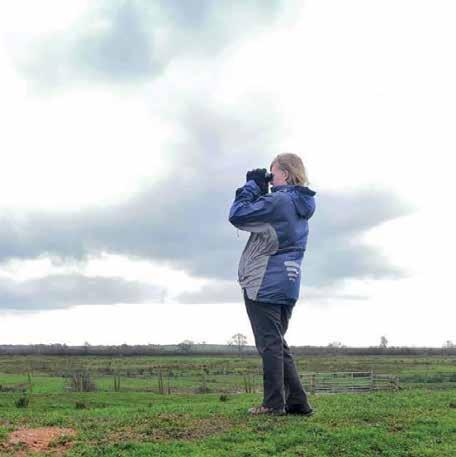
4 minute read
SHELDUCK MIGRATION
Unravelling Shelduck Migration
More WeBS counts of Shelduck in June, July and August could help fill gaps in knowledge about how Shelduck move around the country during the period of their moult migration.
Ros Green BTO Research Ecologist
Despite being such a common and conspicuous species, there is still much to learn about Shelduck migration and moult strategies in the UK. A recent BTO review (Green et al. 2019) has consolidated what is known, and a tracking study (Green et al. 2020) has improved our knowledge of how quickly Shelduck can migrate across the North Sea. However, lots of knowledge gaps have also been highlighted, which more WeBS data could help to fill.
The majority of British breeding Shelduck migrate to the Wadden Sea (The Netherlands and Germany) between late-June and September to moult their flight feathers, though several UK moulting sites also exist, including the Firth of Forth, the Humber Estuary, The Wash, Bridgwater Bay and the Mersey Estuary. Little is known about which Shelduck from which populations migrate to which moult sites. Do west coast breeders use UK moult sites, while east coast breeders travel to the continent? Do males, females and immature birds travel to different areas? No-one seems to know, and here’s where your data collection can help!
We’d love to know how Shelduck numbers fluctuate across the country during the non-core WeBS months. We suspect that numbers might reduce on the west coast as they increase on the east coast between June and August, and that known UK moulting
Recording ratios of male to female Shelducks could help scientists understand their migration strategies
estuaries will see an increase in numbers, as numbers in smaller sites decrease. Count data from these months would really help build up a picture of how Shelduck move about the county during migration. Any data on the sex or age class of birds would also be helpful. Thank You.
You can enter proportions of male and female or adult and immature birds from your site in WeBS Online using the % symbol next to the species count box. Guidance on how to record sex and age ratios in WeBS Online can be found on pages 6–9 or on the counter resources page of the WeBS website www.bto.org/webs-counter-resources References:
Green, R.M.W., Burton, N.H.K. & Cook, A.S.C.P. 2019. Review of the migratory movements of Shelduck to inform understanding of potential interactions with offshore wind farms in the southern North Sea. BTO Research Report 718, BTO, Thetford, UK.
Green, R.M.W., Burton, N.H.K. & Cook, A.S.C.P. 2020. Pilot tracking study of the migratory movements of Shelduck to inform understanding of potential interactions with offshore wind farms in the North Sea. BTO Research Report 725. BTO, Thetford, UK.
Ruth Thomas – the journey
Despite suffering life threatening injuries, Ruth made a remarkable recovery and her work on Curlews on the Solway helped her achieve a Degree that once looked out of reach...
Ruth Thomas WeBS Counter
Ruth Thomas was a budding Zoology student at the University of Cumbria with a dream of a successful career in ecology and conservation ahead of her when it all came crashing down, literally, in July 2018 after she was critically injured in a major car crash in the Lake District.
Airlifted to the Critical Care Unit at the Royal Preston Hospital with what the doctor on board the helicopter described as some of the most serious injuries he had ever seen, Ruth spent three weeks in a coma and a total of three months in hospital, suffering nine fractures to her pelvis and lower spine and a Traumatic Brain Injury, having to learn to walk and talk again, but determined to return to her studies and, as she describes them, “her birdies”.
And, just over a year after the crash, Ruth returned to Carlisle to complete her final year. Ruth’s passion for ornithology never left her and ultimately formed the basis of her dissertation entitled “A Study Assessing the Effectiveness of WeBS Core Counts on Curlew numbers on the Solway Firth”.
Ruth could be found morning and evening, almost daily over a several month period, out in all weathers, recording Curlew on the estuary and hinterlands; a bird with a UK conservation status of Red-listed and thus
GUY BROOME
monthly counts are vital for monitoring their numbers. Ruth’s study set out to prove that the established WeBS monthly core count methods for wetland birds did not account for all the birds present in one day.
A small area of the Solway Firth between Boustead Hill and Drumburgh was selected to perform the study and a circuit devised that included the estuary habitat WeBS already covers plus the adjacent farmland that WeBS does not record. This is due to wading birds like Curlew feeding on both habitats. The local WeBS count organiser kindly provided the official WeBS count numbers to which Ruth compared her numbers and found that in one month a
Following her accident, studying Curlews on the Solway became Ruth's passion


significant number of Curlew were recorded that had not been seen by the WeBS counter. Hence it could be concluded that including hinterland numbers when performing WeBS core counts is vital in recording all Curlew present.
Ruth has since graduated university with a 2:1 honours degree and is currently looking for work in the ecology and conservation fields.
You can follow Ruth on Twitter at @zoologyruth










